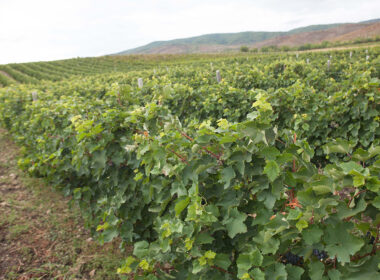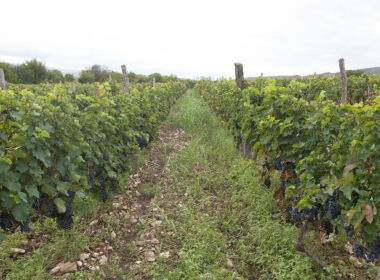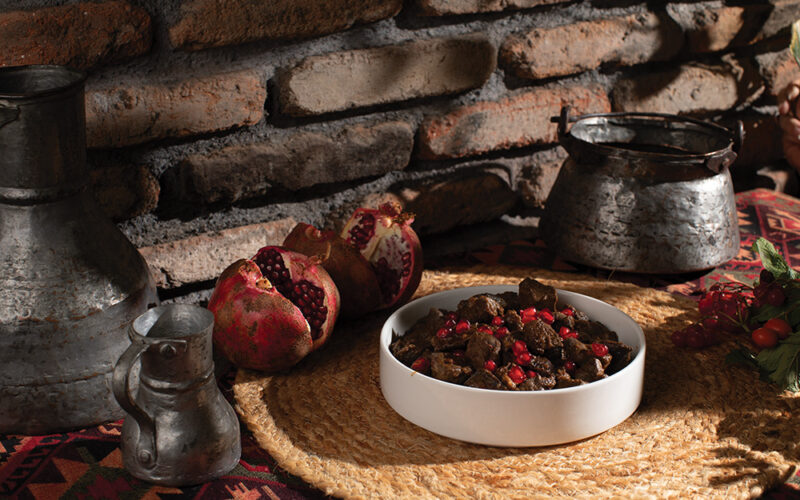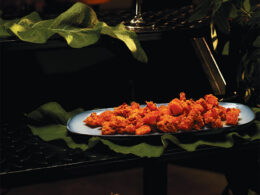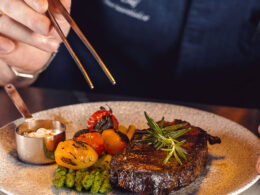| Keti Kvichidze |
Tusheti, a historical-geographic region of Georgia, spans across the primary ridge of the Caucasus mountains, residing on its northern slope. It shares borders with Dagestan in the east, Pshavi, and Khevsureti in the west, Chechnya in the north, and Kakheti in the south. As per the current administrative delineation, the entire territory of Tusheti falls within Akhmeta municipality.
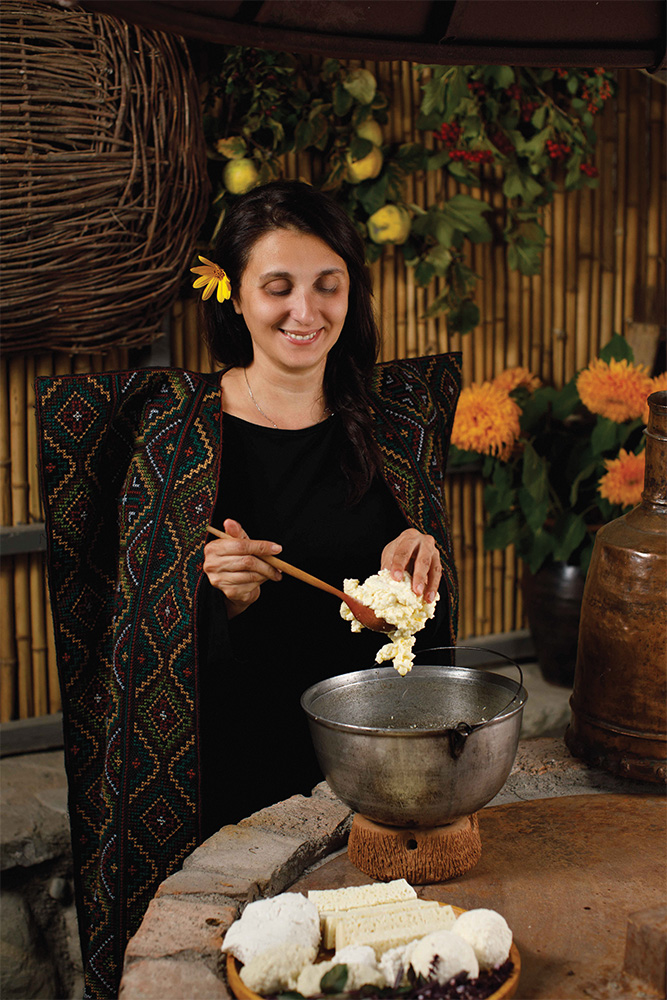
The majority of Tushetians live in Akhmeta district, spending their winters there. Lagvani is a small, cozy and picturesque wine cellar in Akhmeta, that is graciously hosted by Sanata and Marika. Upon entering the courtyard, a beautiful vegetable garden, a traditional tone (bread oven), a stone oven, a khinkali preparation corner, a marani (wine cellar) and a tasting area immediately catch your eye.
Upon arrival, we were welcomed by enormous trays adorned with an array of herbs, wild mushrooms, marinades, and an assortment of fruits. Meanwhile, the enticing aroma of linden tea filled the air of the tasting area, decorated with vibrant Tushetian carpets and handicrafts. It was evident that an intriguing gastronomic journey awaited us.


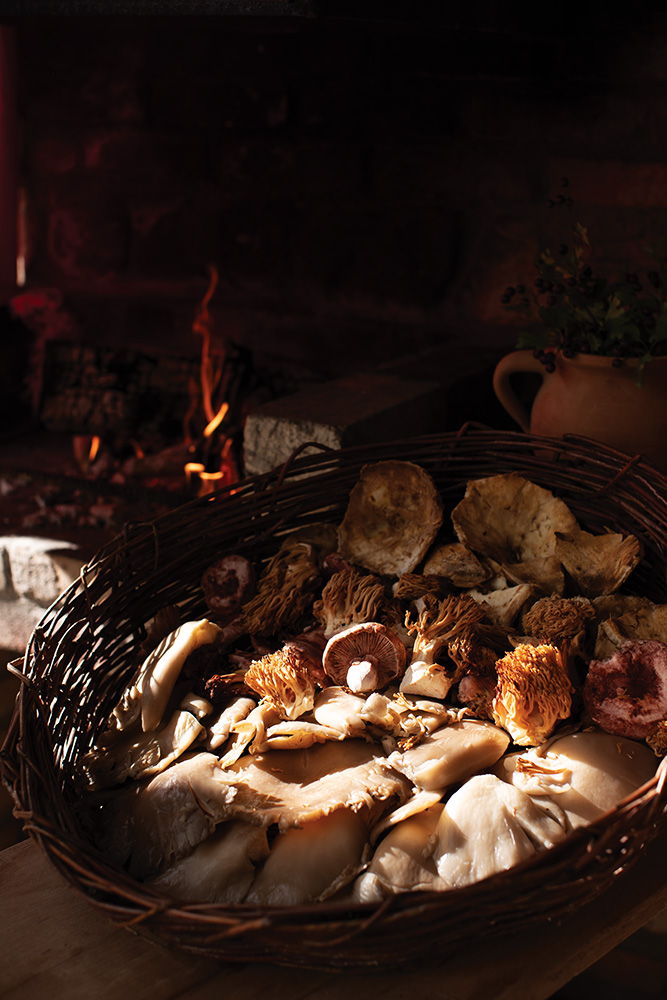
Tushetian Cheese Variety
Gudis Kveli
Tushetian Gudis kveli (Guda Cheese) is the primary product of the region’s cuisine. This cheese variety is included in the registry of Intangible Cultural Heritage of Georgia.
Guda cheese has been made since ancient times in the mountainous regions of Georgia. It boasts a unique flavour profile and an ancient production technique. To a Georgian, deda’s puri (traditional bread) and guda cheese, represent the epitome of native cuisine: they retrieve hot lavash (flat bread) from the tone oven, spread freshly churned sour butter on it, place a piece of guda cheese atop, and savor it.
Tushetian Guda cheese is made from whole, raw, cow’s and sheep’s milk, which matures in a sack (Guda) made out of sheep’s skin. Tushetians commonly call a cheesemaker – Kodis Deda or Sarkala, and cheese production typically takes place during the summer, coinciding with the completion of Doli (lambing season).
Sheep’s unskimmed milk is filtered through a special net which has been strewn with medicinal herbs such as Thymus and Persian wheat. After the cheese is made, it is placed inside a Guda with several other pieces of fresh cheese, separated by layers of salt, then sealed. This assembly is later moved to a cheese room and covered with Nabadi (traditional Caucasian burka) to ensure that the cheese absorbs the salt evenly. The sack is turned and shaped multiple times throughout the day. The aging process lasts around two months.
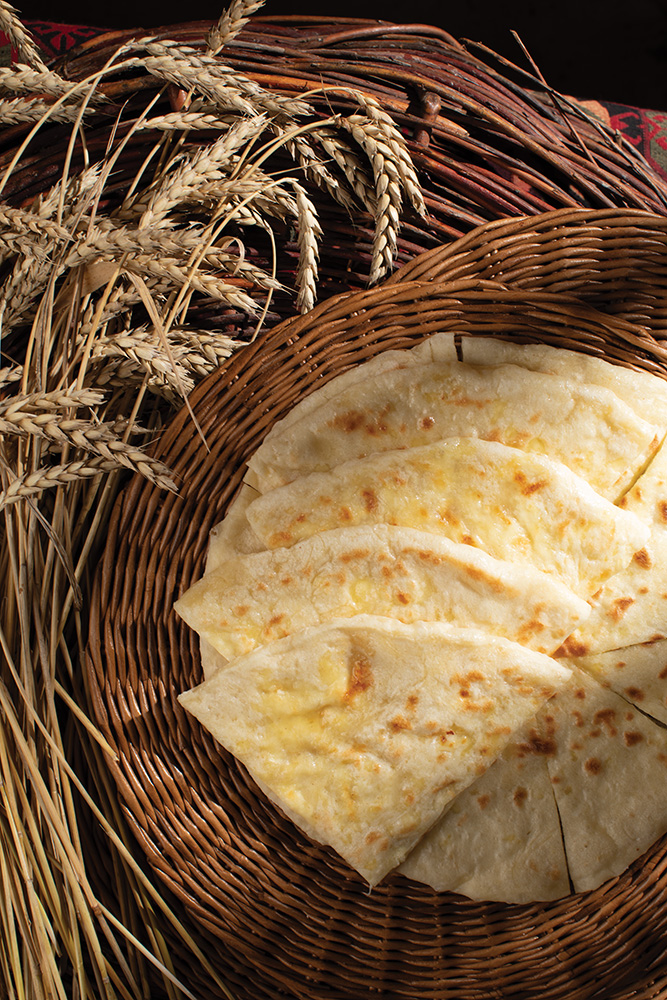
Chogi and Kalti
Chogi is a variety of a cheese spread made from raw sheep’s milk. Unlike guda cheese, it is placed in a wooden barrel, the bottom of which is layered with pieces of birch wood, so that the whey from the cheese can be completely drained. The barrel is covered with a valve and kept in a dark place for about a week, Afterwards the barrel is opened and lightly mouldy cheese is removed.
Kalti holds an honourable position alongside Chogi and Guda cheese. It’s another traditional Tushetian product made from the residual whey remaining after the production of Tushetian guda cheese during the summer.
It is crafted by shepherds. The process involves heating the whey (usually over a wood fire), while stirring it with a wooden spoon to ensure that the mass does not stick to the bottom of the vessel. The obtained Kalti (curd like mass) is placed into fabric bags, squeeze-drained, and once removed, is placed into a woven wooden cage to dry. This cheese can be stored in two ways: fresh cheese balls are laid out on boards to dry or they are rubbed with salt and placed in a sheep skin sack (guda).
Kalti has a strong aroma, a soft texture and a zesty taste. Shepherds who consider this cheese to be a staple during the winter, make it in small quantities for their personal enjoyment.
Tushetian Cheese Based Dishes
Sanata’s assistant, Marika from Tusheti, energetically prepared Kotories for us, to welcome us after the long journey, reflecting the characteristic vigor of this region. Kotori is a thin Khachapuri (cheese bread) made from Kalti. Its yeast-free dough is carefully kneaded, ground Kalti is then formed into a ball and placed on the stretched-out dough, which is then sealed and cooked on a frying pan. After baking, lard is spread on top, and it’s served piping hot.
Another dish prepared from Kalti is called Khavitsi. A significant quantity of lard is melted and thoroughly combined with ground Kalti, the finished mixture is served as a dip, traditionally enjoyed with Georgian shoti bread.
Meat Based Dishes
Tushetian cuisine is unimaginable without Khinkali, it is an essential dish ingrained in the region’s rituals. It’s prepared not only during the lkhini’s supra (celebratory feast) but also for the chiri’s supra (a repast meal). Here, they used to host a khinkali festival as well, usually held before the start of Great Lent. Traditionally, Housewives would begin cooking early in the morning, preparing oversized Khinkali and sharing them with neighbors. At home, they would also arrange a khinkali table to honor the spirits of the departed.
Khinkali is also called mrgvali puri (round bread) in Tusheti. It’s made with minced lamb or beef, as pork isn’t commonly consumed in the mountainous regions.
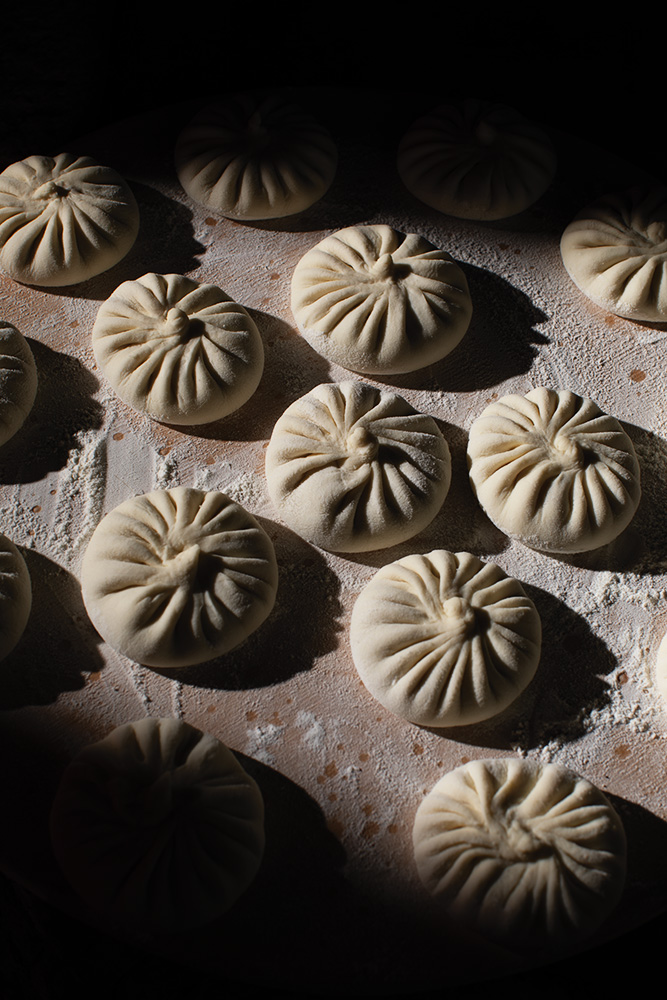
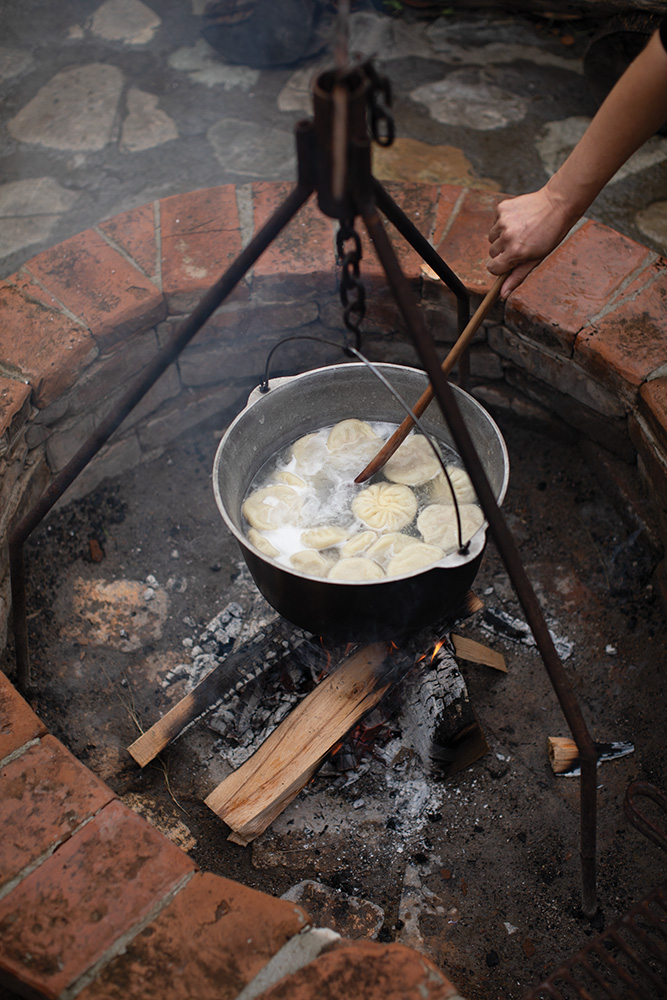
Sheep farming is highly developed in Tusheti, which is connected to the creation of another dish – choban kaurma. This is a shepherd’s dish, which is traditionally cooked in guda (sheep skin sack). Diced lamb chops are places inside a guda, the sack is then carefully tied to allow a small opening for air circulation. This bundle is then positioned inside a dug out pit in the ground, embers are carefully arranged on top, and the dish is left to slow-cook for approximately eight hours. The resulting steam tenderizes the meat, making it soft and flavourful.
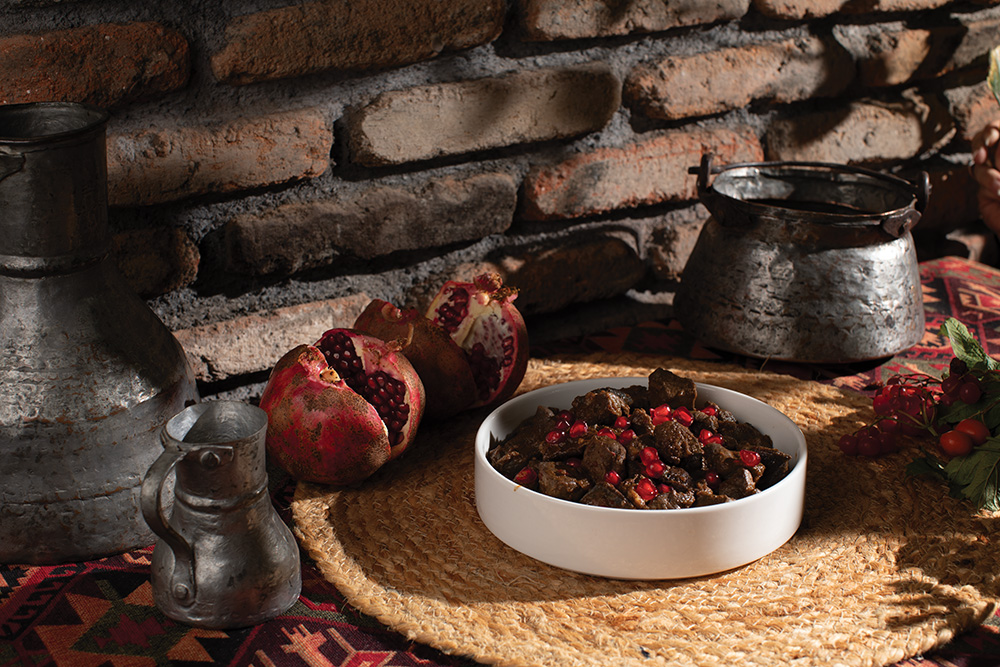
Various theories exist about the origins of cooking under the ground: one suggests that in the mountains, using a guda (sheep skin sack) was more practical for shepherds than using a pot. Another theory proposes that they prepared the dish secretly, away from sheep owners’ notice, whilst a third theory suggests that due to the lengthy cooking time, shepherds couldn’t afford constant attention, making cooking under the ground the safest method to leave the meat unattended for an extended period of time.
Kaghi is mutton which has been cured with salt and then sundried. It is considered a delicacy that keeps well in the winter. Served thinly sliced, it goes well with Saperavi qvevri wine, as its spicy, intense flavour leaves a pleasant finish.
When we prioritize local food, we’re making a significant political statement. / Carlo Petrini | Author and founder of the International Slow Food Movement/
Georgian cuisine, much like the Georgian alphabet, traditional dances, songs, and qvevri wine, embody our unique identity, setting us apart from the rest of the world. Tushetian cheese products, kaghi, khinkali, Begkondara tea, and kumeli (ancient traditional Tushetian sweets made from both barley flour and ground flax) are PDO products, of which the correct brand positioning will have a great influence on the development of Georgian gastronomy and the growth and development of its tourism and gastro-tourism sphere.
თუშური გემოები
ქეთი კვიჭიძე
თუშეთი საქართველოს ისტორიულ-გეოგრაფიული მხარეა, კავკასიონის მთავარი ქედის გადაღმა, მის ჩრდილოეთ კალთაზე. აღმოსავლეთით თუშეთს საზღვრავს დაღესტანი, დასავლეთით ფშავი და ხევსურეთი, ჩრდილოეთით ჩეჩნეთი, სამხრეთით – კახეთი. დღევანდელი ადმინისტრაციული დაყოფით თუშეთის მთელი ტერიტორია ახმეტის მუნიციპალიტეტის შემადგენლობაში შედის.
თუშების უმრავლესობა ახმეტის რაიონში ცხოვრობს და ზამთარს იქ ატარებს. „ლაგვანი“ ახმეტაში პატარა, მყუდრო მარანია, სადაც მასპინძლობას სანათა და მარიკა გვიწევენ. ეზოს ზღურბლზე ფეხს გადადგამთ თუ არა, დაინახავთ ლამაზ ბაღ-ბოსტანს, თონეს, ფურნეს, ხინკლის მოსახარშ ალაგს, მარანსა და სადეგუსტაციო სივრცეს.
აქ ჩამოსულებს უზარმაზარ ხონჩებზე გაშლილი მწვანილის, ტყის სოკოს, მწნილეულისა და ხილის ნაირსახეობა შემოგვაგებეს, ფერადი თუშური ხალიჩებითა და ხელნაკეთი ნივთებით გაწყობილ სადეგუსტაციო სივრცეში კი ცაცხვის ჩაის სურნელი ტრილებდა. უკვე ვიცოდით, რომ წინ საინტერესო გასტრონომიული თავგადასავალი გველოდა.
თუშური ყველის ნაირსახეობა
გუდის ყველი
თუშური გუდის ყველი ამ კუთხის სამზარულოს უმთავრესი პროდუქტია. ყველის ეს სახობა საქართველოს არამატერიალური კულტურული მემკვიდრეობის ძეგლთა სიაშია შეტანილი.
მთიანეთში. ის უნიკალური გემოთი და დამზადების უძველესი ტექნოლოგიით გამოირჩევა. ქართველისთვის დედას პური და გუდის ყველი ყველაზე მშობლიური საკვებია: თონიდან ცხელ-ცხელ ლავაშებს რომ ამოყრიან, ზედ ახლადადღვებილ მომჟაო კარაქს გადაუსვამენ, ზემოდან გუდის ყველის ნაჭერს დაადებენ და ისე მიირთმევენ.
„თუშური გუდა“ ცხვრისა და ძროხის შერეული, ნედლი, მოუხდელი რძისგან დამზადებული ყველია, რომელიც ცხვრის ტყავის გუდაში მწიფდება. თუშები მეყველეს „კოდის დედას“ ან „სარქალას“ ეძახიან. ეს ყველი მხოლოდ ზაფხულში მზადდება, მას შემდეგ, რაც ცხვარში „დოლი“ (ბატკნების მოგება) დასრულდება. ცხვრის ცხიმმოუხდელ რძეს სპეციალურ ბადეში ფილტრავენ, რომელშიც სამკურნალო ბალახებია ჩაფენილი, მათ შორის დიკა, ბეგქონდარა. შემდეგ ყველს ამოიყვანენ. გუდაში რამდენიმე თავს ჩადებენ, ფენებს შორის მარილს მოაყრიან და თავს მოუკრავენ. ამის შემდეგ საყველე ოთახში გაიტანენ და ორი დღის განმავლობაში, ნაბაგადაფარებულს ინახავენ, რათა მარილი ყველის თავებს თანაბრად გაუჯდეს. გუდას დღის განმავლობაში რამდენჯერმე აბრუნებენ და ფორმას უცვლიან. ასეთ მდგომარეობაში ყველი მინიმუმ ორი თვის განმავლობაში მწიფდება.
ჩოგი და კალტი
ჩოგი მდნარი ყველია, რომელიც ცხვრის ნედლი რძისგან მზადდება. გუდის ყველისაგან განსხვავებით, მას ხის კასრში ათავსებენ, რომლის ძირშიც არყის ხის ნაჭრებს აფენენ, რათა ყველიდან შრატი ბოლომდე გამოიწუროს. კასრს სარქველი აფარებენ და დაახლოებით ერთი კვირის განმავლობაში ბნელ ადგილას დგამენ, შემდეგ ხსნიან და ამოაქვთ უკვე შეობებული ყველი.
ჩოგის და გუდის ყველის გვერდით საპატიო ადგილს იკავებს კალტი. ესეც თუშური ტრადიციული პროდუქტია, რომელსაც მწყემსები ზაფხულის პერიოდში, თუშური გუდის ყველის წარმოების შემდეგ დარჩენილი შრატისგან ამზადებენ. შრატს აცხელებენ (ჩვეულებრივ, შეშის ცეცხლზე), ურევენ ხის კოვზით, რათა ჭურჭლის ძირს არ მიეკრას. მიღებულ კალტს წურავენ ქსოვილის ტომსიკებში, შემდეგ კი ხის მოწნულ გალიაში აშრობენ. ეს ყველი ორი სახით ინახება: გასახმობად ნედლ ბურთულებს ალაგებენ ფიცრებზე, ხოლო ნედლი სახით მარილში გადაზელენ და ცხვრის ტყავში (გუდაში) დებენ. კალტს მკვეთრი სუნი აქვს, რბილი კონსისტენციისაა და ცხარე გემო დაჰკრავს. მწყემსები, რომელთათვისაც ეს ყველი ზამთრის პერიოდში ერთ-ერთი ძირითადი პროდუქტია, მას მცირე რაოდენობით, მხოლოდ საკუთარი მოხმარებისთვის ამზადებენ.
ყველისგან მომზადებული თუშური კერძები
სანათას დამხარე ქალი – თუში მარიკა ამ კუთხისთვის დამახასიათებელი სისხარტით დატრიალდა და შორი გზიდან ჩამოსულებს კოტორები დაგვიცხო. კოტორი კალტისგან დამზადებული თხელი ხაჭაპურია, რომლის ცომი საფუარის გარეშე იზილება. დაფხვნილ კალტს ბურთის ფორმას მისცემენ, გაშლილ ცომში ჩადებენ, თავს მოუკრავენ და ტაფაზე გამოაცხობენ. ცხელ-ცხელს ზემოდან ერბოს დაადებენ და ისე მიირთმევენ. კალტით მზადდება კიდევ ერთი თუშური კერძი – ხავიწი. ბლომად ერბოს დაადნობენ, შიგ კალტს ჩაფშხვნიან და კარგად ჩაზილავენ. მზა ხავიწში დედას პურს ჩააწობენ და მიირთმევენ.
ხორციანი კერძები
თუშური კულინარია ხინკლის გარეშე წარმოუდგენელია. ამ კუთხეში ეს სარიტუალო კერძია, რომელსაც ლხინის დროსაც ამზადებენ და ჭირის სუფრისთვისაც. აქ ხინკალობის დღესასწაულიც კი ჰქონდათ, რომელიც ხორციელის პირველ კვირაში (დიდი მარხვის დაწყებამდე) ტარდებოდა: დიასახლისები დილიდანვე იწყებდნენ სამზადის, დიდი ფორმის ხინკალებს მოხარშავდნენ და თითოეულ მეზობელს ჩამოურიგებდნენ, შინ კი ხინკლის ტაბლას დადგამდნენ მიცვალებულების სულის მოსახენებლად.
ხინკალს თუშეთში „მრგვალ პურსაც“ ეძახიან. ის ცხვრის ან საქონლის ხორცისგან მზადდება, რადგან მთაში ღორის ხორცს არ მიირთმევენ.
თუშებში მეცხვარეობა მეტადაა განვითარებული, რასთანაც არის დაკავშირებული კიდევ ერთი კერძი – ჩობან ყაურმა. ეს მწყემსების კერძია, რომელიც კლასიკური სახით – გუდაში მზადდება. ცხვრის ხორცს დაჭრიან, გუდაში ჩაალგებენ, თავს მოუკრავენ ისე, რომ ჰაერისთვის პატარა ნახვრეტს დაუტოვებენ და მიწაში ამოთხრილ ორმოში ჩადებენ, ზემოდან ნაკვერჩხალს დააყრიან და რვა საათი ამზადებენ. ხორცი ორთქლში ითუშება, შედეგად კი რბილი და ნაზი ხდება.
არსებობს რამოდენიმე ვერსია საჭმლის მიწაში მომზადებაზე: ერთი, რომ მთაში, მწყემსებისთვის ქვაბის ნაცვლად გუდის გამოყენება უფრო ადვილი და მოსახერხებელი იყო, მეორე – მეპატრონისგან მალულად ამზადებნენ კერძს, ხოლო მესამე ვერსიით, რადგან ხორცი ხანგრძლივად იხარშებოდა, მწყემს დრო არ ჰქონდა მთელი პროცესისთვის მიექცია ყურადღება, ამიტომ უსაფრთხო გზა იყო მისი მიწაში დიდი ხნით დატოვება.
ყაღი – ეს არის გამოშრალი ცხვრის ხორცი. ითვლება დელიკატესად. მისი მომზადების წესი ასეთია: ცხვრის ნამზეურ ხორცს (სუკი) მარილში გამოიყვანენ და მზეზე გამოშრობენ. ყაღი ზამთარში კარგად ინახება. თხლად დაჭრილი ძალიან უხდება ქვევრის საფერავს, მისი პიკანტური, მძაფრი გემო სასიამოვნო დაბოლოებას ტოვებს.
„როდესაც ლოკალურ საკვებს ვანიჭებთ უპირატესობას, ჩვენ ამით უმნიშვნელოვანეს პოლიტიკურ გადაწვეტილებას ვიღებთ.“
კარლო პეტრინი | International Slow Food Movement-ის ავტორი და დამფუძნებელი.
ქართული სამზარეულო ჩვენი იდენტობის ნაწილია, როგორც ქართული ანბანი, ქართული ცეკვა და სიმღერა, ქვევრის ღვინო – ეს არის ის, რაც განგვასხვავებს და გამოგვარჩევს დანარჩენი მსოფლიოსგან. თუშური ყველის ნაწარმი, ყაღი, ხინკალი, ბეგქონდარას ჩაი, ქუმელი (უძველესი ტრადიციული თუშური ტკბილეული, რომელიც მზადდება როგორც ქერის ფქვილისგან, ისე დანაყილი სელისგან) ადგილწარმოშობის პროდუქტებია, რომელთა სწორ პოზიციონირებასაც დიდი გავლენა ექნება ქართული გასტრონომიის, ტურიზმისა და გასტროტურიზმის ზრდასა და განვითარებაზე.

